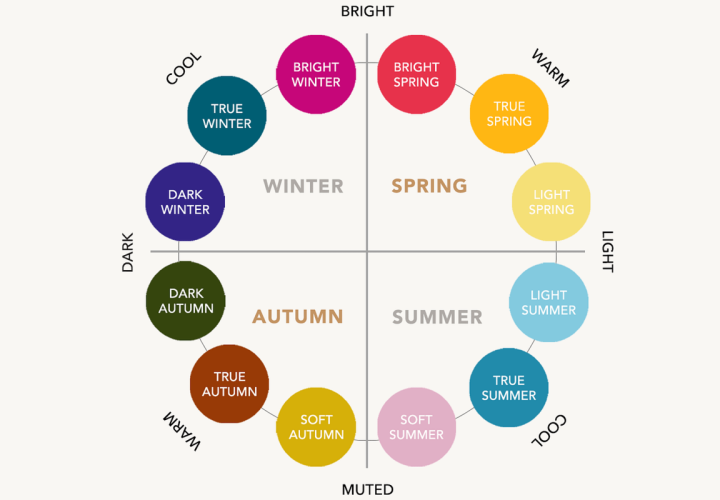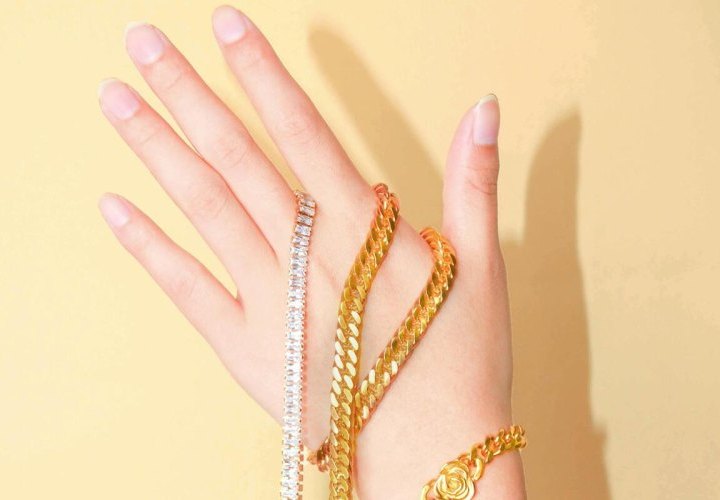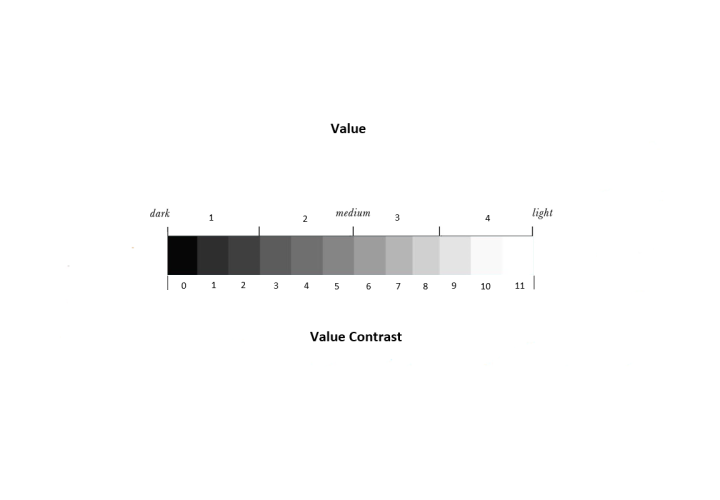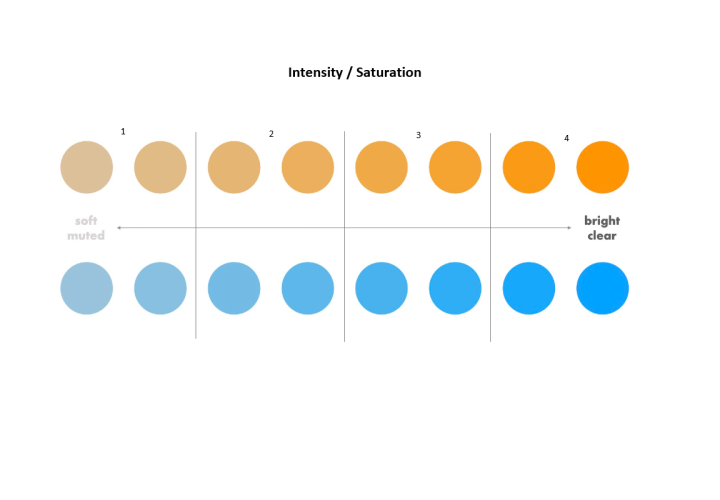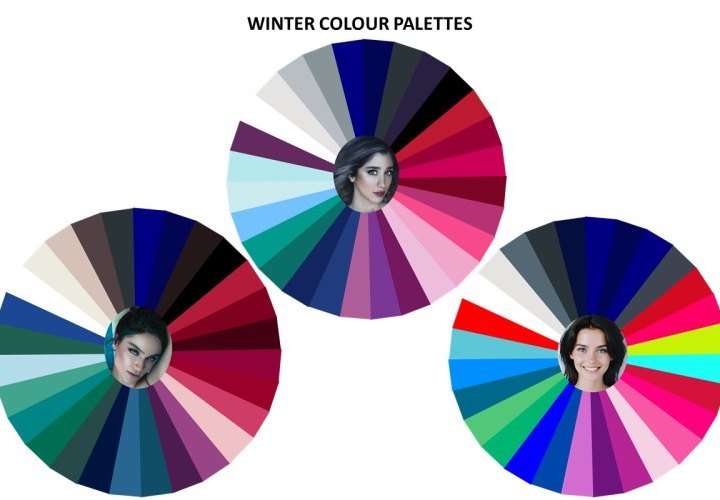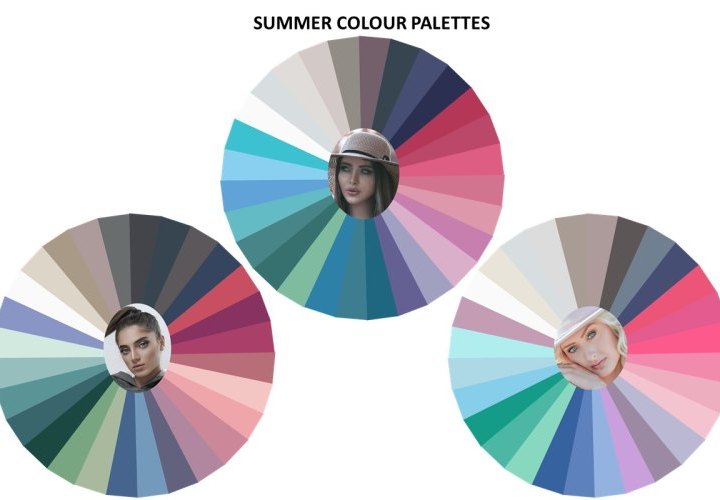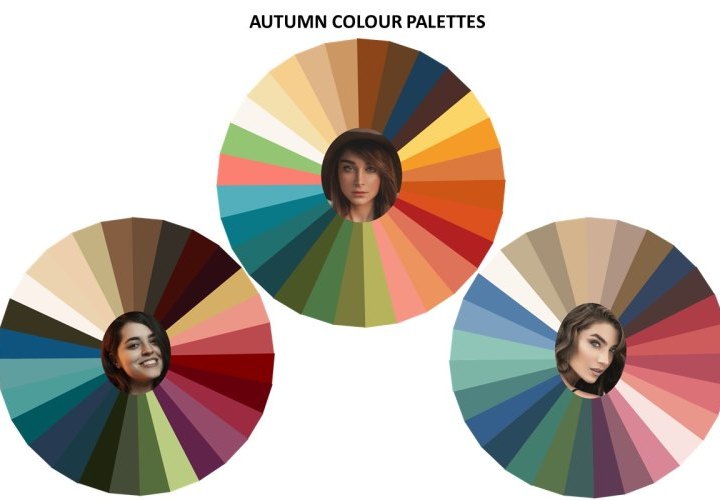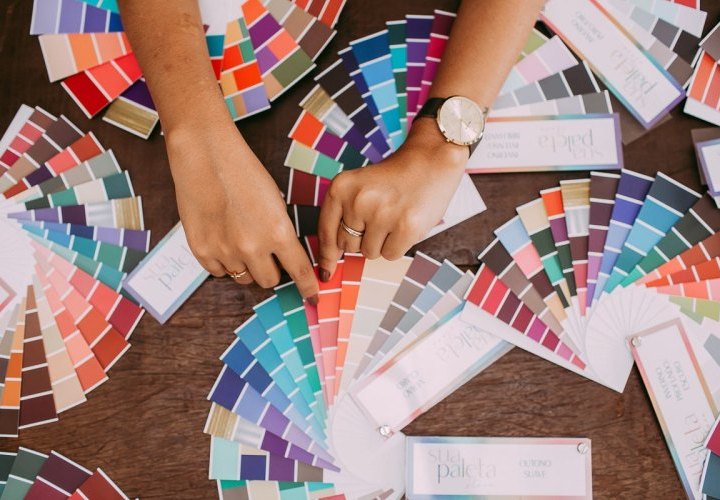Take our free 12 and 16 Seasonal Colour Analysis Quiz (What season am I?) and find out what season are you and what colours will look best on you based on your seasonal colour palette. According to the 12 Seasonal Colour Analysis system, there are 12 season types (more information about the 16 season types will be provided at Results), because each of the 4 seasons (Winter, Spring, Summer, Autumn) has three variations. In order to tell you which of the twelve season types you fall into, the quiz focuses on 3 aspects: 1) it will help you see if you have a warm or cool skin undertone, 2) it will help you determine your value (light or dark), and 3) it will help you find out your chroma (soft/muted or bright). The 4 seasons have the following characteristics:
- Summer (Cool, more
- Spring (Warm, Light, Bright)
- Autumn (Warm, Dark, Soft/Muted).
Based on your season type, you will see what kind of colours harmonize with you and will be able to adjust your colour palette.
1. Grab a piece of white paper or white cloth and hold it next to your bare face in the mirror. Don’t forget to cover your hair with a white towel. How does your skin look like against true white? (If your skin has a warm undertone, it will appear yellowish, golden or peachy, and if you have a cool undertone, it will appear bluish, purple or rose pink.)
A) My skin appears bluish, purple, or rose pink (cool pink) next to the white paper or cloth.
B) My skin appears yellowish, golden, or peachy next to the white paper or cloth.
Metal Test
2. In natural sunlight, put both silver and gold against your skin (preferably thicker necklaces or bracelets). Which one harmonizes best with your skin undertone?
A) Silver
B) Gold
Vein Test
3. more
A) Mostly blue or purple
B) Mostly green
Magenta and Orange Test
4. In natural sunlight, hold next to your bare face (with no make-up) a cloth/fabric that is magenta and take a picture of yourself. In the same light, hold next to your face a bright orange cloth/fabric and take a picture. If you have shirts of these colours, it’s even better if you actually put them on. How do you look?
A) I look better next to the magenta cloth/fabric.
B) I look better next to the orange cloth/fabric.
Sun Test
5. Do you tan easily?
A) No, I usually burn first.
B) Yes, I tan easily.
Results:
All or mostly A(s): you have a cool skin undertone.
All or mostly B(s): you have a warm skin undertone.
If you couldn’t answer some of the above questions, you may have a neutral skin undertone. Skip this part for now and focus on part 2 and 3.
The value of your overall colouring is light if you have light hair, skin and eyes and there is low contrast between your features in your desaturated photo. The value of your overall colouring is dark if you have dark hair, eyes (the whites of your eyes create a high contrast), and skin or dark hair and eyes, but a lighter skin and there is high contrast between the features. As a rule of thumb, your dominant features determine your depth. You might have very light or medium light features (for example skin), more
1. Are you light or deep or in between? To determine the value of your overall colouring (how light or dark your overall colouring is), convert a photo of your own into greyscale and see where your overall colouring falls on the value scale from 1 to 4 (see the top numbers on the greyscale image). Remember your number (1, 2, 3 or 4).
A) 1 - dark
B) 2 - medium-dark
C) 3 - medium-light
D) 4 - light
Now let’s see what is your value contrast - the level of difference in value between two or more colours. The closer together colours are, the lower is the level of contrast between them, and the farther apart colours are, the higher is the level of contrast. For example, neighbouring hues of two medium greys have low contrast because their values are very similar, while black and white are highly contrasted because their values are very different.
2. What contrast is there between your skin, hair, and eyes? This question is not part of the quiz, but if you have doubts after taking the quiz, you can check the contrast for different seasons. To determine your contrast level, use the same desaturated photo and the bottom numbers of the greyscale photo on your right on the web page and assign values to the 3 elements of your face: hair, skin, and eyes. Assign each element a value from 0 to 11. Now, take your highest number and take away the lowest number (for example 11-1=10). What number do you get?
A) 0 - 2 (low value contrast)
B) 3 - 5 (medium-low value contrast)
C) 6 - 8 (medium-high value contrast)
D) 9 - 11 (high value contrast)
Remember your value contrast. It will help you find out how light and dark the colour values of your clothes should be. If you got a high value contrast, you can wear highly contrasted colours with very different values without problems, but if you got a low value contrast, you should opt for colours with similar values. For example, Dark Winter has a high value contrast, while Light Spring has a low value contrast. At the same time, keep in mind that your clothes should not be more than X (number you got) values apart.
1. Are you soft/muted or bright/clear? To determine your chroma, look at your colour photo and the image on your right on the web page and assign numbers from 1 to 4. Observe whether your face, hair and eyes are more vibrant and full of colour or more muted. On our image, you can see the scale of orange and blue colours from soft/muted to bright/clear. more
Tip: You will be bright/clear (3 or 4), if you are warm and light (3 or 4), or cool and dark (1 or 2). And you will be soft/muted (1 or 2), if you are warm and dark (1 or 2), or cool and light (3 or 4).
A) 1 - soft
B) 2 - medium-soft
C) 3 - medium-bright
D) 4 - bright
Remember the number you got (1, 2, 3 or 4).
After taking the Seasonal Colour Analysis Quiz, please see the Results below. If you want to find out more about Seasonal Colour Analysis, you can also join and follow our:
(´。• ᵕ •。`) ♡ Seasonal Colour Analysis Facebook Group
Winter
- Dark/Deep Winter (Cool, Dark 1, Bright 3)
- Cool/True Winter (Cool, Dark 2, Bright 3)
- Bright/Clear Winter (Cool, more
Spring
- Bright Spring (Warm, Light 3, Bright 4)
- Warm/True Spring (Warm, Light 3, Bright 3)
- Light Spring (Warm, Light 4, Bright 3)
Summer
- Light Summer (Cool, Light 4, Soft 2)
- Cool/True Summer (Cool, Light 3, Soft 2)
- Soft Summer (Cool, Light 3, Soft 1)
Autumn
- Soft Autumn (Warm, Dark 2, Soft 1)
- Warm Autumn (Warm, Dark 2, Soft 2)
- Dark Autumn (Warm, Dark 1, Soft 2)
After finding out what is your season type, you can check what are the best colours for your season. You can also buy our Self Seasonal Colour Analysis Guide (15 €) to colour analyse yourself at home and compare the results with those of the Colour Analysis Quiz. You can even purchase a seasonal colour palette fan (for example, Warm Spring Colour Palette Fan) and take it with you when you go shopping. At the same time, you can receive a free Online Personal Colour Analysis as a gift upon purchase of a tour in Italy or Spain of at least 1,000 €.
Exceptions. You might be an exception to the rules, if for example you have 2 warm, light and bright features (for example really orange hair and bright blue eyes), and 1 cool feature (for example cool pink skin undertone). In this case your results might be: Cool, Light, Bright. You will still fit into the warm category because with 2 warm features and 1 cool feature, you will be warm leaning. Respectively, if you have 2 cool features and 1 warm feature, you will be cool leaning. If you are light and bright or dark and soft, you will fit into the warm category, and if you are dark and bright or light and soft, you will fit into the cool category. Anyway, if you have doubts between two seasons, you can always try the draping test and see what colour palette is more flattering for you or contact us for a Personal Seasonal Colour Analysis Online.
Now that you know what season are you based on the 12 season types, you can go further and see what is your season type based on the 16 Seasonal Colour Analysis system. Based on the Sci\ART Method developed by Kathryn Kalisz, which is one of the most recognized approaches to the 16 season types system, the Sci\ART method is different from the 12 season types system because it separates out a “True” from a “Warm” or “Cool” season type by creating four variations under each of the four seasons. In the 12 season types system, these are combined as the same thing (for example True/Warm Spring).
The 16 seasons are:
Winter: True, Cool, Dark and Bright
Summer: True, Cool, Light and Soft/Muted
Spring: True, Warm, Light and Bright
Autumn: True, Warm, Dark and Soft/Muted
A true season (True Winter, True Summer, True Spring and True Autumn) has equal proportions in its characteristics. For example, True Winter is equally cool, dark and bright (33/33/33), True Summer is equally cool, light, and soft/muted, True Spring is equally warm, light and bright, and True Autumn is equally warm, dark and soft/muted.
After discovering your season type based on the 12 season types, you can check if you are a True season. Copy the photo including the Winter, Spring, Summer or Autumn Colour Palettes (based on your season type) and paste it in PowerPoint. Insert your photo (please see how to take a photo for colour analysis by clicking on the Online Colour Analysis button, then following to Steps and Conditions) over each of the 3 season variations (for example if you are a Spring, insert your photo over each of the 3 Spring Colour Palettes: Bright Spring, Light Spring and Warm Spring) and see if you look equally great against all of them or you look better against one specific palette.
1. Do you look equally great against all 3 colour palettes of your season (Winter, Summer, Spring or Autumn)?
A) - Yes, I look equally great against all 3 colour palettes of my season
B) - No, I look better against one specific colour palette.
A true season will look equally great against all 3 palettes, so if you do, you are a true season based on the 16 season types. If you look better against one specific palette (for example Bright Spring, Warm Spring or Light Spring), then you are not a true season and there is a dominant characteristic in your features (for example bright, warm or light).
If you want a professional colour analysis performed by a specialist, you can opt for our Online Seasonal Colour Analysis which includes:
Standard Package (40 €) - 50% off for requests received until the end of March 2025.
- Your Colour Analysis;
- Your Colour Palette (30 colours and neutrals);
- Your Jewellery.
Premium Package (100 €)
- Your Colour Analysis;
- Your Value Contrast and Colour Contrast;
- Your Jewellery;
- Your Colour Palette (30 colours and neutrals);
- Your Best Colour Combinations.
Your Online Seasonal Colour Analysis and Online Morpho-visagism Analysis (180 € for both) includes:
- Your Colour Analysis;
- Your Value Contrast and Colour Contrast;
- Your Colour Palette (30 colours and neutrals);
- Your Best Color Combinations;
- Your Morpho-visagism Analysis;
- Your Best Hair Colours based on your season type and Hairstyle(s) based on your face shape (morpho-visagism analysis);
- Your Jewellery based on your season type and face shape.

